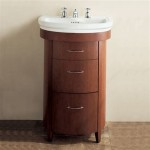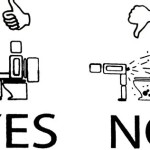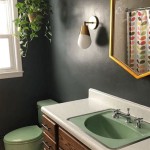How to Clean Black Mold from Bathroom Tiles
Black mold, often identified by its dark greenish-black color and musty odor, poses a health hazard and aesthetic nuisance in bathrooms. Its presence indicates excessive moisture and requires prompt remediation. The following guide outlines effective methods for removing black mold from bathroom tiles.
Safety Precautions
Before beginning the cleaning process, prioritize safety. Mold exposure can trigger allergic reactions and respiratory issues. Implement these precautions:
- Wear protective gear: N95 respirator mask, gloves, and eye protection are essential.
- Ventilate the area: Open windows and doors to maximize airflow.
- Isolate the bathroom: Close the door to prevent mold spores from spreading to other rooms.
Cleaning Solutions for Black Mold
Several cleaning solutions effectively combat black mold. Select the most appropriate option based on the severity of the mold growth and material of the tiles.
- Bleach Solution: A diluted bleach solution (1 part bleach to 10 parts water) is a potent mold killer. However, it can discolor certain surfaces, so test in an inconspicuous area first. Avoid using bleach on porous tiles like natural stone.
- White Vinegar: Undiluted white vinegar is a milder, natural alternative to bleach. While it may take longer to eradicate mold, it's less harsh on surfaces.
- Baking Soda Paste: A paste of baking soda and water provides a gentle scrubbing agent that helps lift mold from tile surfaces.
- Commercial Mold Cleaners: Specialized mold and mildew cleaners offer powerful cleaning action. Always follow the manufacturer's instructions carefully.
- Hydrogen Peroxide: A 3% hydrogen peroxide solution can effectively kill mold and lighten stains without producing harmful fumes.
Cleaning Procedure
The cleaning process involves several steps to ensure complete mold removal and prevent regrowth.
- Prepare the area: Remove any loose debris, soap scum, or other build-up from the tiles.
- Apply the cleaning solution: Spray or apply the chosen cleaner liberally to the affected area, ensuring thorough saturation.
- Allow dwell time: Let the solution sit for 10-20 minutes to penetrate the mold and break it down.
- Scrub the tiles: Using a stiff-bristled brush, scrub the grout lines and tile surfaces vigorously to remove the mold. For stubborn mold, a grout brush or old toothbrush can provide more precise cleaning.
- Rinse thoroughly: Rinse the area with clean water to remove all traces of the cleaning solution and mold debris.
- Dry the area completely: Use a clean cloth or towel to dry the tiles and grout lines thoroughly. A fan or dehumidifier can expedite the drying process and discourage mold regrowth.
Preventing Mold Recurrence
After cleaning, implementing preventative measures is crucial to minimize the chances of future mold outbreaks.
- Control moisture: Address the root cause of the mold by fixing leaks, improving ventilation, and using exhaust fans during showers.
- Regular cleaning: Routine cleaning of bathroom surfaces with appropriate cleaning agents helps prevent mold from taking hold.
- Monitor for regrowth: Regularly inspect bathroom tiles and grout lines for any signs of mold reappearance. Address any new growth promptly using the cleaning methods described.
Dealing with Porous Tiles
Porous tiles, like natural stone, require special consideration due to their absorbency. Bleach and harsh chemicals should be avoided as they can damage the surface.
- Test cleaning solutions: Always test any cleaning solution on an inconspicuous area first to ensure compatibility.
- Opt for milder cleaners: Prioritize gentler cleaning agents like white vinegar or baking soda paste.
- Consult a professional: For severe or persistent mold on porous tiles, consider consulting a professional tile and grout cleaner.
Addressing Extensive Mold Growth
For widespread or deeply ingrained mold, professional intervention may be necessary.
- Professional assessment: A mold remediation specialist can assess the extent of the problem and recommend appropriate solutions.
- Specialized techniques: Professionals utilize specialized equipment and techniques to effectively remove mold and prevent its return.
- Safety considerations: Professional remediation ensures safe and thorough mold removal, minimizing health risks.
Maintaining Clean Grout
Grout, due to its porous nature, is particularly susceptible to mold growth. Maintaining clean grout is essential for preventing mold recurrence.
- Regular scrubbing: Scrub grout lines regularly with a grout brush and appropriate cleaning solution.
- Grout sealant: Applying a grout sealant creates a barrier that prevents moisture penetration and inhibits mold growth.
- Replace damaged grout: If grout is severely damaged or stained, consider replacing it to eliminate mold and improve the bathroom's appearance.

Black Mold In The Shower How To Clean It Kitchen With Matt

How Do I Remove Black Mould From Shower Floor

What Do About Black Mold In The Bathroom Bob Vila

How To Clean Mold In Shower Grout Tips And Tricks Certified Care

Black Mold In The Shower How To Clean It Kitchen With Matt

Black Mold In The Shower How To Clean It Kitchen With Matt

Learn How To Remove Black Mold From Shower Silicone Sealant Clean Deep Cleaning Tips House

Cleaning Mrs Hinch Fans Share How To Remove Black Mould From Bathroom Grout Express Co

How To Get Rid Of Mold In The Shower On Bathroom Walls Clorox

How To Clean Bathroom Tile And Grout Reviews By Wirecutter
Related Posts







